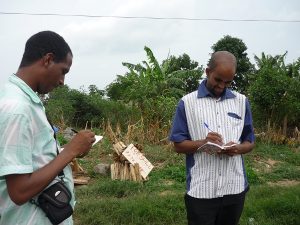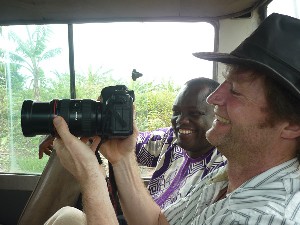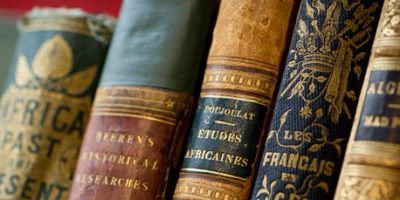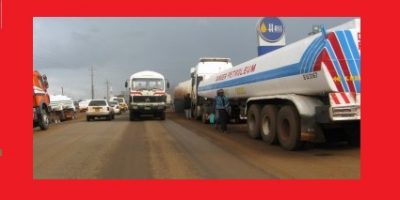Workshop: ‘Methodologies under Duress’ – CTD methods, 31 March – 4 April 2014
The third day of the workshop in Buea, Cameroon (31 March – 4 April 2014) focused on the methodology of the CTD project. Following presentations by Inge Ligtvoet and Prof. Oka Obono, the participants explored the CTD methods of 1) senses, 2) visuals and 3) digitalisation:
Method 1: Senses
To encourage participant to use their senses in order to collect data. The nine researchers in the CTD team were split up in 3 teams and sent out to specific locations in the town of Buea, i.e.; a bar, a road and the market.

Each individual in the group was given the task to gather data through only one of the senses: the first one would use the sight to collect data, the second one focused on hearing and listening and the third one concentrated on smell.
The capturing of the data was done through photo and video recording for sight, audio recording for hearing and olfactory memory for smell.
After two hours of “fieldwork” each group held a presentation on their findings, like this one. All teams agreed that when one is merely focussed on using one sense it is impossible to appreciate the total identity of the field. This made everbody wonder if the absence of sensing would need to be incorporated into our research methodology?
Method 2: Visuals
On Thursday Sjoerd Sijsma led a discussion about the various dimensions of visual methods as applied in our research project. He opened with the quote: “photography and film is like writing with light”
He emphasized the multiple uses of visual data in the project as:
- promotion;
- presentations;
- teaching, and;
- ‘data’.
Visual data are as important as audio data and written text. And they demand a similar procedure: from collecting  to archiving to product/analysis.
to archiving to product/analysis.
The role of the new media is increasingly important both as research field and as research tool. Those who are studying it have to embrace it, join it, and become part of it.
The project has various subprojects where visual methods and output are interrelated:
- Participatory observation → Audio-Visual data;
- Interviews + Images + Photos → Clip/Vodcast /Theses;
- Documenting → Short films/Documents;
- Research + Film → Documentary/Art project films;
- Collective multi media → Art project website.
As an example of participatory observation ‘recording an eye-witness’ is discussed. It is crucial to be well-prepared: clear role division in the team, good understanding of the technology, thorough preparation of the interview.
In the short film of Inge Butter’s fieldwork (edited by Sjoerd), the camera on a tripod is similar to a silent observer. The images are very powerful. This form of collecting visual data is simple and easy in public places. Applied in private places a good relationship with the informants is important.
In the afternoon, the same reader/researcher pairs as Monday were asked to work together once again. This time the researcher interviewed the reader about their thoughts on the research of the interviewer. Upon completion the participants turned these interviews into vod- and/or podcasts.
Sjoerd added the following to his opening quote:
“if filming and raw pictures are the words and sentences, then editing is the story telling, a way to reach out to your audience”.
Only by diving into the editing process, does one discover what it is that one has collected and maybe even more importantly, what is missing to tell the story. And eventhough how one tells a story consist of a personal choice, a specific style, there is a necessity to capture the right moments, sufficient amounts of:
- situations;
- developments in time, and/or;
- links to the past, present and future.
Method 3: digitalisation
Eefje Gilbert described the endeavours of the CTD project concerning the pioneering stance it has taken in the virtualising of the research environment and more specifically what it means for researchers to work in this kind of environment. CTD has made (digital) connecting and archiving part of their methodologies, wherein they connect with others (researchers but also the public) to share a digital archive of their research data.
To enter the domain of the virtual, one has to assume a ‘collective’ or ‘sharing’ attitude, a wish to partake in a ‘collective intelligence’ (CI) network, in which
“no one knows everything and everyone knows something”.
Eefje pointed out that this very attitude is at loggerheads with the current requirements on academia of individual success and specialised fields of expertise. She saw this difference in approach as one of the main reasons why the VRE delivered by the University Library did not work for their project.
She finished by asking the participants to think about tools, methods and techniques used for 1) knowledge retention, 2) knowledge assessment, 3) knowledge acquisition, and 4) knowledge transfers, which will enable rather than prohibit academics to access the virtual world. A previous presentation on this subject, by Mirjam de Bruijn and Eefje Gilbert on this subject can be found here.
Lotte Pelckmans’ power point presentation gave an overview of:
- Method: Online social media’s effect on methods and epistemological approaches in social sciences. Few words have been said about ethics, which are however very important. We plan to address the topic of ethics/ethical protocol in the future.
- CTD exposure through online platforms and media: The way in which the CTD project uses platforms and digital media for outreach (visibility & exposure) and interaction (sharing & dialogue).
- CTD members methods used: The way in which using digital data (twitter, facebook) have been ‘mined’ by the researchers in our project. Catherina and Djimet were invited to give examples from their fields (these have been excluded from the powerpoint for privacy reasons).
Get more stuff like this
in your inbox
Subscribe to our mailing list and get interesting stuff and updates to your email inbox.


